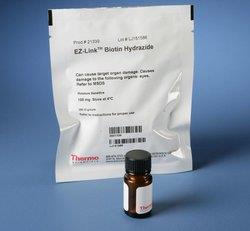
代理商EZ-Link™ Hydrazide-Biotin 试剂_100 mg
100 mg
-
原厂型号
-
-
品牌
-
单件重量
-
货期
|
Thermo Scientific EZ-Link Hydrazide-Biotin is the shortest and simplest hydrazide-activated biotinylation reagent for labeling glycoproteins and other carbohydrate-containing compounds having oxidizable sugars or aldehydes.
Features of EZ-Link Hydrazide-Biotin: • Glycoprotein labeling—biotinylate glycosylated proteins at sialic acid residues for detection or purification using streptavidin probes or resins This biotin hydrazide reagent enables simple and efficient biotin labeling of polyclonal antibodies and other glycoproteins. Mild oxidation of antibodies with sodium periodate produces reactive aldehydes on the carbohydrate moieties of the Fc portion that can be modified by hydrazides. This approach is advantageous for labeling antibodies because biotinylation occurs only at the sites of glycosylation, which are primarily in the Fc region of the antibody, far from the antigen binding site. We manufacture biotin reagents to ensure the highest possible overall product integrity, consistency and performance for the intended research applications. Biotinylation reagents differ in reactivity, length, solubility, cell permeability and cleavability. Hydrazides and alkoxyamines are two types of carbonyl-reactive groups. Hydrazides (—NH-NH2) react specifically with aldehyde groups in slightly acidic conditions to form hydrazone linkages; these can be further reduced to stable secondary amine bonds using sodium cyanoborohydride (Part No. 44892). The reaction is more efficient in the presence of aniline (Part No. 88944). Alternatively, hydrazides can be conjugated to carboxylic acids using EDC carbodiimide chemistry. Reactive aldehyde groups can be generated in glycoproteins and other polysaccharide compounds by oxidation of constituent sugar diols using sodium periodiate (Part No. 20504). Sialic acid residues are common components of protein glycosylation and are easily converted to aldehydes with 1 mM NaIO4. Related Products
|
无参数
